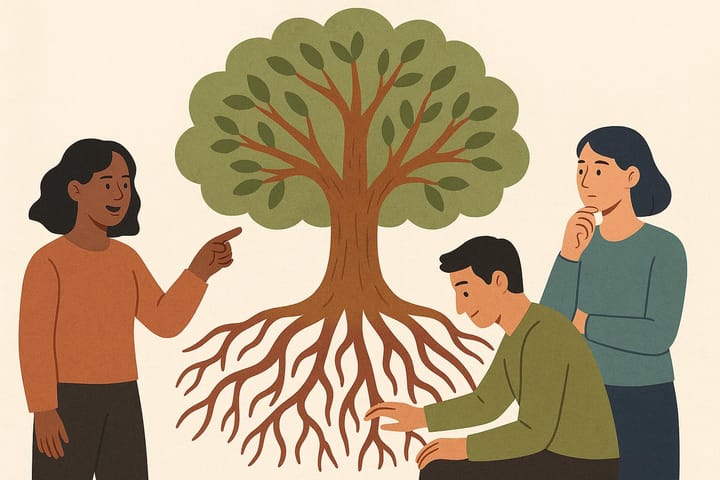Why Metaphors Matter in Leadership Storytelling
Explore how metaphors enhance leadership storytelling, simplify complexity, and foster emotional connections in team communication.

Metaphors are powerful tools for leaders. They simplify complex ideas, make messages memorable, and help teams connect emotionally. By using relatable comparisons, leaders can explain abstract concepts in ways that everyone can understand, fostering better communication and alignment.
Key Takeaways:
- Simplify Complexity: Metaphors turn difficult ideas into relatable ones (e.g., comparing organisational change to steering a ship).
- Boost Engagement: Storytelling with metaphors helps build trust and makes messages stick.
- Create Shared Understanding: Consistent metaphors align teams and improve decision-making.
- Practical Tips: Use clear, concise, and relevant metaphors that resonate with your audience.
Want to inspire your team and communicate better? Start by introducing one strong metaphor in your next conversation.
Master the Art of Storytelling: Why Metaphors Matter ...
How Metaphors Affect the Mind
Metaphors play a key role in making ideas stick, especially when used alongside storytelling. They help people process and remember information more effectively.
How the Mind Processes Metaphors
Unlike straightforward language, metaphors invite the brain to connect abstract ideas with familiar experiences. This process encourages deeper thinking, making complex concepts easier to grasp. As a result, messages conveyed through metaphors tend to leave a lasting impression.
Memory Benefits of Metaphor-Based Stories
Metaphors act as mental anchors, helping people recall and apply important ideas. When used in leadership storytelling, they make strategic or organisational messages more engaging and easier to internalise. This combination of clarity and memorability gives metaphors a powerful edge in effective communication.
Making Complex Ideas Simple
Leaders often use metaphors to make complex ideas easier to understand, building on how these comparisons enhance memory and comprehension.
Closing Knowledge Gaps
Explaining intricate strategies to a diverse team can be challenging. Metaphors help bridge communication gaps, making complicated concepts easier to grasp.
For instance, when discussing organisational change, a leader might avoid abstract terms like "operational transformation" and instead compare the organisation to a ship adjusting its course. A small shift in the rudder, they might explain, can lead to a dramatically different destination over time.
The trick is picking metaphors that resonate with your team's experiences and knowledge. Here are some tips:
- Use industry-specific analogies to build on what your team already knows.
- Choose culturally relevant references that feel familiar to your audience.
- Keep metaphors clear and concise, explaining them in just a sentence or two.
- Test your metaphors with a variety of people to ensure they work across different perspectives.
Next, let’s look at how metaphors can make abstract ideas feel more concrete.
Converting Abstract to Concrete
Abstract concepts become easier to understand when tied to real-world experiences. This approach helps team members not only grasp the idea but also remember it more effectively.
Here are some examples of turning abstract concepts into relatable metaphors:
| Abstract Concept | Concrete Metaphor | Key Benefits |
|---|---|---|
| Data Security | Home Security System | Highlights the importance of protecting valuable assets |
| Market Competition | Sports Tournament | Relatable ideas of rules, strategy, and competition |
| Innovation Process | Gardening | Shows how ideas need nurturing and time to grow |
The most effective metaphors share these traits:
- Immediate recognition: They connect to experiences people are familiar with.
- Clear visuals: They create vivid mental images.
- Emotional connection: They tap into universal human experiences.
- Practical insight: They suggest actionable steps or solutions.
When creating metaphors, aim to make them:
- Relevant to your audience’s context.
- Easy to understand without overcomplicating.
- Memorable so they stick in people’s minds.
- Actionable, providing clear takeaways.
The best metaphors come from understanding the challenges your team faces daily. They should clarify complex ideas, not make them harder to understand, acting as a bridge between theory and practical application.
Creating Common Understanding
When teams share common metaphors, they create a shared mental model that makes communication and decision-making easier. The right metaphors can help teams align their understanding of complex challenges and solutions.
Team Alignment Through Metaphors
Metaphors simplify abstract ideas, but they also serve another purpose: aligning team understanding. They act as tools to create shared mental frameworks, helping diverse teams approach complex concepts from the same angle.
Here are some ways to use metaphors to bring your team into alignment:
- Define 2–3 key metaphors that capture your team's main goals and challenges.
- Use these metaphors consistently in meetings, documents, and discussions.
- Encourage teams to adapt the metaphors to their specific contexts.
For instance, if your team uses the metaphor of "building a house" to explain project management:
| Project Phase | House-Building Metaphor | Team Understanding |
|---|---|---|
| Planning | Blueprint creation | Clear vision and detailed plans |
| Foundation work | Laying the groundwork | Establishing core systems and processes |
| Construction | Building the structure | Development and implementation |
| Interior design | Enhancing user experience | Adding finishing touches and polish |
Choosing the Right Metaphors
For metaphors to work effectively, leaders need to choose ones that resonate with the team. The metaphor should fit the team's context and the message you want to communicate.
Good metaphors share these qualities:
- Universal: They make sense across different cultural and professional backgrounds.
- Relevant: They connect to the team’s everyday work and challenges.
- Flexible: They can adapt as the project or organisation evolves.
- Simple: They’re easy to understand and explain.
When introducing a new metaphor:
- Test it with a small group to ensure it’s clear.
- Explain why the metaphor is relevant to the team’s work.
- Invite team members to contribute their own ideas to expand on it.
Metaphors should make things clearer, not more confusing. If the team finds the comparison hard to follow, it’s better to switch to a metaphor that feels more natural and intuitive for everyone.
Measuring Metaphor Success
Leaders can evaluate how well metaphors are working by looking at results in trust, engagement, productivity, and psychological safety. This approach helps leaders refine how they use metaphors to achieve better outcomes.
Tracking Key Outcomes
To assess the impact of metaphors, leaders should focus on specific results tied to storytelling, including:
- Team trust and psychological safety: Are team members feeling more secure and supported?
- Engagement and productivity: Are people more involved and efficient in their work?
- Communication clarity: Is the message being understood more easily and effectively?
Collecting Team Feedback
Regular surveys and open discussions are essential for understanding if metaphors are resonating with the team. Honest feedback helps leaders make adjustments, ensuring metaphors continue to bring both short-term and long-term benefits.
Prioritising Results
Metaphors can immediately boost engagement and communication while also fostering stronger team cohesion over time. By focusing on these results, leaders can adapt their communication strategies to meet the changing needs of their team and support organisational goals.
At Leadership Story Bank (https://leadershipstorybank.com), we emphasise the importance of mastering metaphors for effective leadership. Regular evaluation and feedback help fine-tune their use, increasing trust, motivation, and the clarity of messages.
Conclusion: Making Metaphors Work
Let’s wrap up with some key points and actionable steps to effectively use metaphors in leadership.
Key Takeaways for Leaders
Metaphors help simplify complex ideas and connect them to relatable concepts, building understanding and emotional engagement within your team.
To use metaphors effectively, they should be:
- Relevant: Reflect your team's experiences and environment
- Memorable: Paint a picture that sticks in people’s minds
- Targeted: Align with your communication objectives
- Genuine: Reflect your personal leadership style
These elements highlight how metaphors can transform abstract concepts into something more relatable and easier to grasp.
How to Start Using Metaphors
Ready to bring metaphors into your leadership approach? Here’s how:
- Try one clear metaphor in your next team discussion to explain an idea.
- Build a library of metaphors that resonate with your team over time.
- Expand gradually as you gain experience and see what works.
These steps can help you communicate more effectively while strengthening team alignment and understanding. Metaphors aren’t just tools - they’re bridges to better leadership.
FAQs
How can I choose metaphors that will truly connect with my team?
Selecting metaphors that resonate with your team starts with understanding their experiences, values, and shared challenges. A well-chosen metaphor should simplify complex ideas, evoke emotion, and create a shared understanding. For example, if your team is navigating a period of change, a metaphor like 'sailing through uncharted waters' could highlight both the uncertainty and the shared journey.
To find the right metaphor, consider the context of your message and the cultural or professional background of your team. Test how the metaphor feels when spoken aloud and ensure it aligns with your core message. A strong metaphor can inspire, clarify, and unify, making your storytelling more impactful and memorable.
How can I effectively use metaphors in my leadership communication?
Metaphors are a powerful tool for leadership communication, helping to simplify complex ideas and create emotional connections with your audience. To incorporate metaphors effectively:
- Identify your message: Be clear about the key idea or emotion you want to convey. A strong metaphor should align with your core message.
- Draw from relatable experiences: Use metaphors rooted in everyday experiences or cultural references that your audience will easily understand.
- Keep it simple: Avoid overcomplicated or obscure metaphors. The best metaphors are concise and immediately resonate with your listeners.
Practising the use of metaphors in your storytelling can make your communication more engaging and memorable, helping you inspire and influence others with greater impact.
How can I evaluate the impact of metaphors on team engagement and communication?
Measuring the impact of metaphors on team engagement and communication involves observing how effectively they resonate with your audience. Pay attention to signs such as increased participation, improved understanding of complex ideas, and stronger emotional connections within the team.
You can also gather feedback directly by asking team members how the metaphor helped them relate to or grasp the message. Additionally, tracking outcomes like enhanced collaboration or more cohesive decision-making can provide valuable insights into the effectiveness of your storytelling approach.



